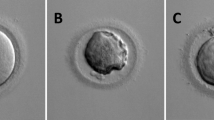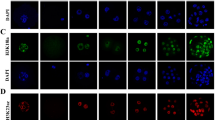Abstract
It remained unknown whether HDAC6 affected the histone deacetylation of in vitro maturation oocytes and the reprogramming of nuclear transplantation in pig. Our results indicated that HDAC6 specific inhibition did not affect overall HDAC activity and meiosis process, which increased histone H3K9/K14 and H4K8 acetylation of porcine in vitro maturation oocytes and pseudo-pronucleus embryos. HDAC6 inhibition also significantly enhanced the cleavage and blastocyst of nuclear transfer embryos (0.81 ± 0.12 vs. 0.68 ± 0.12 and 0.46 ± 0.19; 0.73 ± 0.13 vs. 0.63 ± 0.18 and 0.40 ± 0.16, P<0.05). The inhibition of HDAC6 significantly enhanced histone H3K9/K14 and H4K8 acetylation, and upregulated the OCT4 and CDX2 expressions (1.83 ± 0.16 vs. 1.00 ± 0.00 %; 2.07 ± 0.09 vs. 1.00 ± 0.00; P<0.05) in porcine SCNT blastocysts. Interestingly, HDAC6 inhibition significantly increased the pseudo-pronucleus volume during somatic cell reprogramming. Thus, HDAC6 was required for porcine histone deacetylation during the in vitro maturation and pseudo-pronucleus stages. HDAC6 inhibition improved the in vitro development of nuclear transfer embryos. HDAC6 may restrict the reprogramming of somatic nuclear transfer by regulating pseudo-pronucleus expansion. We need further research to confirm this in the future.
Graphical Abstract










Similar content being viewed by others
References
Agalioti T, Chen GY, Thanos D. Deciphering the transcriptional histone acetylation code for a human gene. Cell. 2002;111(3):381–92.
Sun JM, Cui KQ, Li ZP, Lu XR, Xu ZF, Liu QY, et al. Suberoylanilide hydroxamic acid, a novel histone deacetylase inhibitor, improves the development and acetylation level of miniature porcine handmade cloning embryos. Reprod Domest Anim. 2017;52(5):763–74.
Sobel RE, Cook RG, Perry CA, Annunziato AT, Allis CD. Conservation of deposition-related acetylation sites in newly synthesized histones H3 and H4. Proc Natl Acad Sci. 1995;92:1237–41.
Parthun MR. Hat1: the emerging cellular roles of a type B histone acetyltransferase. Oncogene. 2007;26(37):5319–28.
Sun J, Cui K, Li Z, et al. Histone hyperacetylation may improve the preimplantation development and epigenetic status of cloned embryos. Reprod Biol 2020.
Guenther MG, Levine SS, Boyer LA, Jaenisch R, Young RA. A Chromatin Landmark and Transcription Initiation at Most Promoters in Human Cells. Cell. 2007;130(1):77–88.
Liang GN, Lin JCY, Wei VV, Yoo C, Cheng JC, Nguyen CT, et al. Distinct localization of histone H3 acetylation and H3-K4 methylation to the transcription start sites in the human genome. Proc Natl Acad Sci U S A. 2004;101(19):7357–62.
Karmodiya K, Krebs AR, Oulad-Abdelghani M, Kimura H, Tora L. H3K9 and H3K14 acetylation co-occur at many gene regulatory elements, while H3K14ac marks a subset of inactive inducible promoters in mouse embryonic stem cells. BMC Genomics. 2012;13:424.
Gurdon JB, Wilmut I. Nuclear Transfer to Eggs and Oocytes. Cold Spring Harb Perspect Biol. 2011;3(6):a002659–9.
Endo T, Kano K, Naito K. Nuclear Histone Deacetylases Are Not Required for Global Histone Deacetylation During Meiotic Maturation in Porcine Oocytes. Biol Reprod. 2008;78(6):1073–80.
Endo T, Naito K, Aoki F, Kume S, Tojo H. Changes in histone modifications during in vitro maturation of porcine oocytes. Mol Reprod Dev. 2005;71(1):123–8.
Ling L, Hu F, Ying X, Ge J, Wang Q. HDAC6 inhibition disrupts maturational progression and meiotic apparatus assembly in mouse oocytes. Cell Cycle. 2018;17(5):550–6.
Akiyama T, Kim J-M, Nagata M, Aoki F. Regulation of histone acetylation during meiotic maturation in mouse oocytes. Mol Reprod Dev. 2004;69(2):222–7.
Zhou D, Choi Y-J, Kim J-H. Histone deacetylase 6 (HDAC6) is an essential factor for oocyte maturation and asymmetric division in mice. Sci Rep. 2017;7(1).
Wang YS, Xiong XR, An ZX, Wang LJ, Liu J, Quan FS, et al. Production of cloned calves by combination treatment of both donor cells and early cloned embryos with 5-aza-2 '-deoxycytidine and trichostatin A. Theriogenology. 2011;75(5):819–25.
Chawalit S, Nguyen NT, Tseng JK, Lo NW, Tu CF, Ju JC. Trichostatin A and Ascorbic Acid Assist in the Development of Porcine Handmade Cloned Embryos via Different Physiologic Pathways. Reprod Sci. 2012;19(9):976–86.
Seidel C, Schnekenburger M, Dicato M, Diederich M. Histone deacetylase 6 in health and disease. Epigenomics. 2015;7(1):103–18.
Eshun-Wilson L, Zhang R, Portran D, Nachury MV, Toso DB, Löhr T, et al. Effects of alpha-tubulin acetylation on microtubule structure and stability. Proc Natl Acad Sci U S A. 2019;116(21):10366–71.
Liu YJ, Peng LR, Seto E, Huang SM, Qiu Y. Modulation of Histone Deacetylase 6 (HDAC6) Nuclear Import and Tubulin Deacetylase Activity through Acetylation. J Biol Chem. 2012;287(34):29168–74.
Zhang Y, Kwon S, Yamaguchi T, Cubizolles F, Rousseaux S, Kneissel M, et al. Mice Lacking Histone Deacetylase 6 Have Hyperacetylated Tubulin but Are Viable and Develop Normally. Mol Cell Biol. 2008;28(5):1688–701.
Zhang X, Yang J, Wang H, Guo R, Yin Y, Zhang D, et al. Overexpression of Hdac6 extends reproductive lifespan in mice. Protein Cell. 2017;8(5):360–4.
Bantscheff M, Hopf C, Savitski MM, Dittmann A, Grandi P, Michon AM, et al. Chemoproteomics profiling of HDAC inhibitors reveals selective targeting of HDAC complexes. Nat Biotechnol. 2011;29(3):255–65.
Sui L, Huang R, Yu H, Zhang S, Li Z. Inhibition of HDAC6 by tubastatin A disrupts mouse oocyte meiosis via regulating histone modifications and mRNA expression. J Cell Physiol. 2020;235:7030–42.
Kim T-Y, Bang Y-J, Robertson KD. Histone Deacetylase Inhibitors for Cancer Therapy. Epigenetics. 2014;1(1):15–24.
Sangalli JR, de Bem THC, Perecin F, Chiaratti MR, Oliveira LJ, de Araújo RR, et al. Treatment of Nuclear-Donor Cells or Cloned Zygotes with Chromatin-Modifying Agents Increases Histone Acetylation But Does Not Improve Full-Term Development of Cloned Cattle. Cell Rep. 2012;14(3):235–47.
Costa-Borges N, Santalo J, Ibanez E. Comparison between the Effects of Valproic Acid and Trichostatin A on the In Vitro Development, Blastocyst Quality, and Full-Term Development of Mouse Somatic Cell Nuclear Transfer Embryos. Cell Rep. 2010;12(4):437–46.
Wang YS, Su JM, Wang LJ, Xu W, Quan F, Liu J, et al. The Effects of 5-Aza-2 '- Deoxycytidine and Trichostatin A on Gene Expression and DNA Methylation Status in Cloned Bovine Blastocysts. Cell Rep. 2011;13(4):297–306.
Kirchhof N, Carnwath JW, Lemme E, Anastassiadis K, Scholer H, Niemann H. Expression pattern of Oct-4 in preimplantation embryos of different species. Biol Reprod. 2000;63(6):1698–705.
Li XP, Kato Y, Tsuji Y, Tsunoda Y. The effects of trichostatin a on mRNA expression of chromatin structure-, DNA methylation-, and development-related genes in cloned mouse blastocysts. Cloning Stem Cells. 2008;10(1):133–42.
Kumar BM, Jin H-F, Kim J-G, Ock SA, Hong Y, Balasubramanian S, et al. Differential gene expression patterns in porcine nuclear transfer embryos reconstructed with fetal fibroblasts and mesenchymal stem cells. Dev Dyn. 2007;236(2):435–46.
Acknowledgements
These experiments were supported from the China National High Technology Research and Development Program (863) Project (2011AA100607), National Natural Science Foundation Project (31260552 and 31401267), Guangxi Natural Science Foundation (Grant No. 2014GXNSFCB118003), and Guangxi Medical University Youth Science Foundation Project (GXMUYSF201829).
Author information
Authors and Affiliations
Corresponding authors
Ethics declarations
Ethics Approval
All experiments were conducted in accordance with the guiding principles of the ethical review committee of Guangxi Medical University.
Conflict of Interest
The authors declare that they have no conflict of interest.
Additional information
Publisher’s Note
Springer Nature remains neutral with regard to jurisdictional claims in published maps and institutional affiliations.
Rights and permissions
About this article
Cite this article
Sun, J., Liu, Q., Lv, L. et al. HDAC6 Is Involved in the Histone Deacetylation of In Vitro Maturation Oocytes and the Reprogramming of Nuclear Transplantation in Pig. Reprod. Sci. 28, 2630–2640 (2021). https://doi.org/10.1007/s43032-021-00533-2
Received:
Accepted:
Published:
Issue Date:
DOI: https://doi.org/10.1007/s43032-021-00533-2




